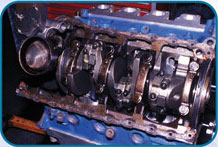Featured Powerplant: 335 Series Cleveland
Here's your guide to Cleveland! A look at Ford's "other" small-block: 351C-351M-400.
Ford's Total Performance mantra was enhanced by the introduction of the Cleveland engine (named for the Cleveland Engine Plant) family. Referred to by their engineering designation "335 Series", Cleveland small-blocks were originally tuned for performance. The "muscle" versions began production in 1970 with the 351C 2V, 351C 4V-CJ, Boss 351 and HO, and finished in 1973 with the 351C CJ. Cleveland V8s also earned an international performance images, since they powered the legendary DeTomaso Pantera.
Because Ford built a lot of mid and full-sized cars, pickups and SUVs, Cleveland engines also had to perform draught service. This was handled by the 400 and 351M versions. Ultimately, the 351C was produced until 1974, 400 production started in 1971 and ended in 1981, while 351M production started in 1975 and ended in 1985. Like other Ford engines of the era, they bore the brunt of emissions and economy regulations with truly low compression ratios and camshafts that were installed retarded.

Let us now walk through the features that defined the Clevelands and how the 351M-400 differed from original 351Cs. Compared to Windsors, Cleveland V8s had three major defining characteristics, and the first two were in the block. It had an integeral front timing cover "hood" that was cast as part of the block, and utilized a stamped cover for the timing chain. The second feature was cooling related. The thermostat was located in the block, on the timing cover top. Hence, coolant exited the heads, into the block and then on into the radiator. This ostensibly helped with faster warm-up and increased cooling efficiency.
Thirdly, canted valve cylinder heads were the Cleveland's trump card. According to Ford, the valves were canted at compound angles in relation to the ports. This reduced valve shrouding and sharp turns associated with single-plane valve layouts; resulting in improved breathing, particularly at high rpm.
Cleveland heads came in two versions, 2V and 4V. The 4V heads had larger intake ports aimed at high-rpm breathing. The 2V heads had smaller port volumes, so they were actually better suited for street use.
Unfortunately, the Cleveland suffered from Ford's lousy exhaust port design. Follow the port interior with your finger, and you feel it rise nicely, until just before the port opening, where it drops down. The opening was lowered slightly to fit the existing exhaust manifold and chassi configureations. But this design created dead spots in the port, which hampered exhaust flow efficiency. In fact, in full-race applications, engine builders would mill off the exterior port extension. Then an aluminum plate matching the ports would be installed. This plate reaised the port opening, which improved exhaust flow.
The Boss and Company
The Boss 351, Ford's ultimate factory performance Cleveland, was produced only in 1971. Boss blocks, like CJs and HOs, had 4-bolt main caps. The 4V heads had closed-style combustion chambers that helped produced a 11.1:1 compression ratio with forged, domed pistons. Another key to Boss 351 power was its solid lifter camshaft. In 1972, the Boss was replaced by the 351 HO. This engine used 4V open chamber heads with forged flat top pistons for an 8.8:1 compression ratio. Likewise, the HO was equipped with a solid lifter cam; Ford's last. Cast cranks that had been tested for hardness were used in both the Boss and HO.
351M/400
Ford needed a small-block torque engine, so they developed the 400. The displacement was the result of increasing the stroke from 3.50 to 4.00 inches. Later, for mileage considerations, the 351M (M for modified), was introduced and it retained the 3.50-inch stroke. Compared to the 351C, the 351M-400 had two major differences: the 1.091-inch taller deck height, and the crank had 3-inch diameter main journals. These engines were not high horsepower, high rpm engines like their old Boss 351 cousin.
Complete article now available in issue #5 of Legendary Ford Magazine
To read this 4-page article in its entirety, including detailed photos on Cleveland engines, hot-rodding your 351M and 400, casting numbers, firing orders and much more visit Legendary Ford Magazine online and subscribe today!
Note: SuperMotors has a business affiliation with Legendary Ford Magazine, which provides Ford, Lincoln, and Mercury articles and content to SuperMotors.
Back to the Issue #5 index.